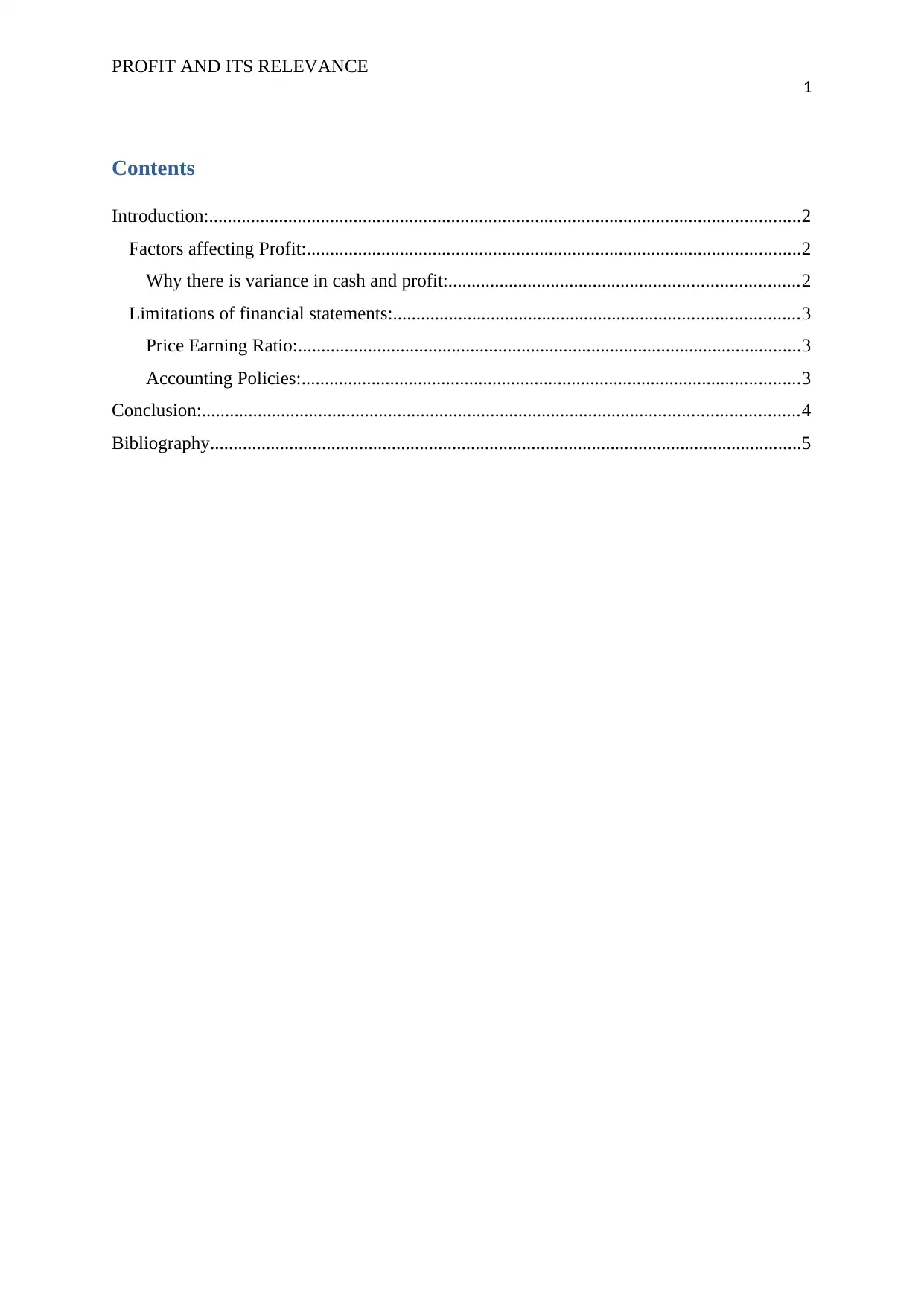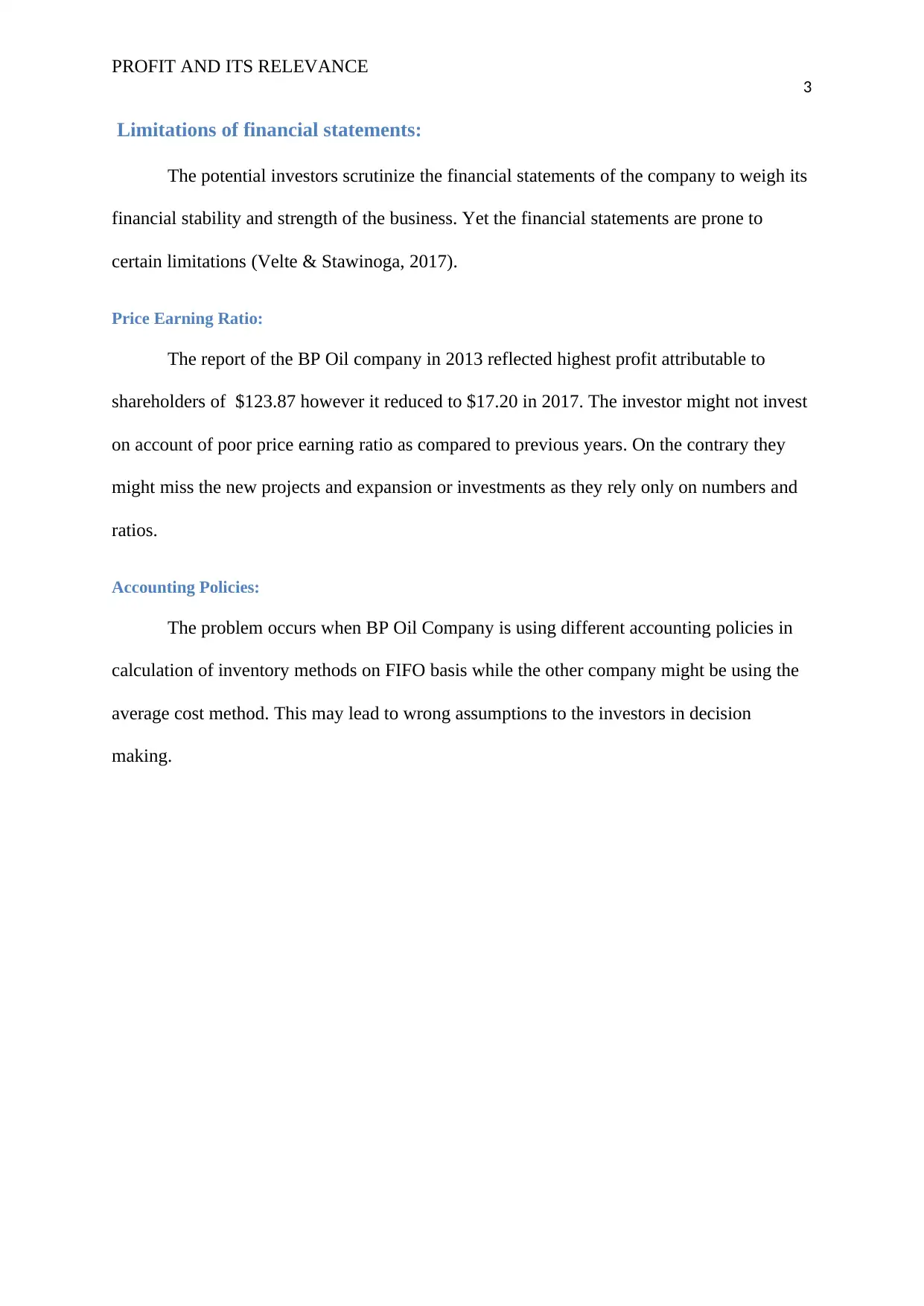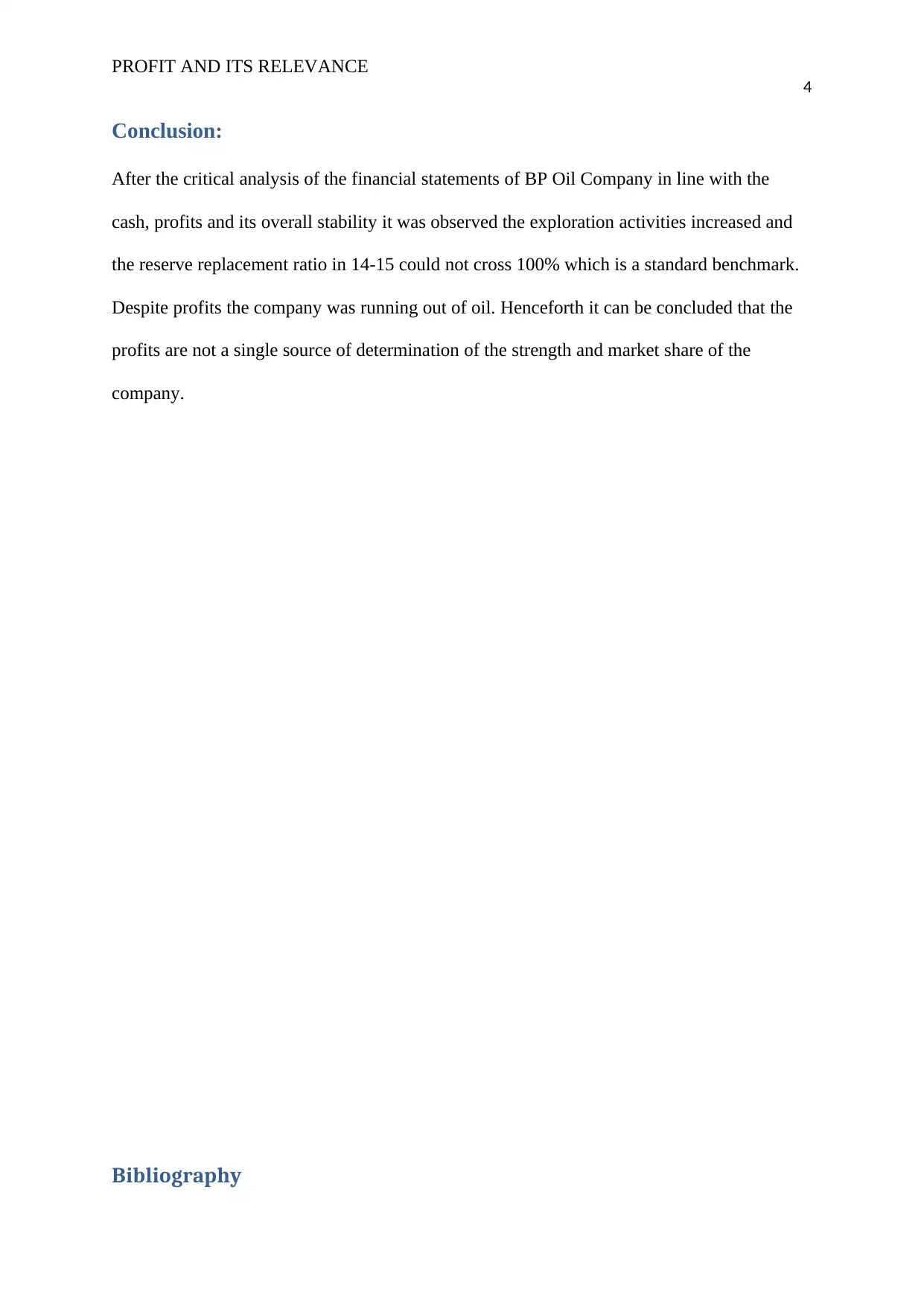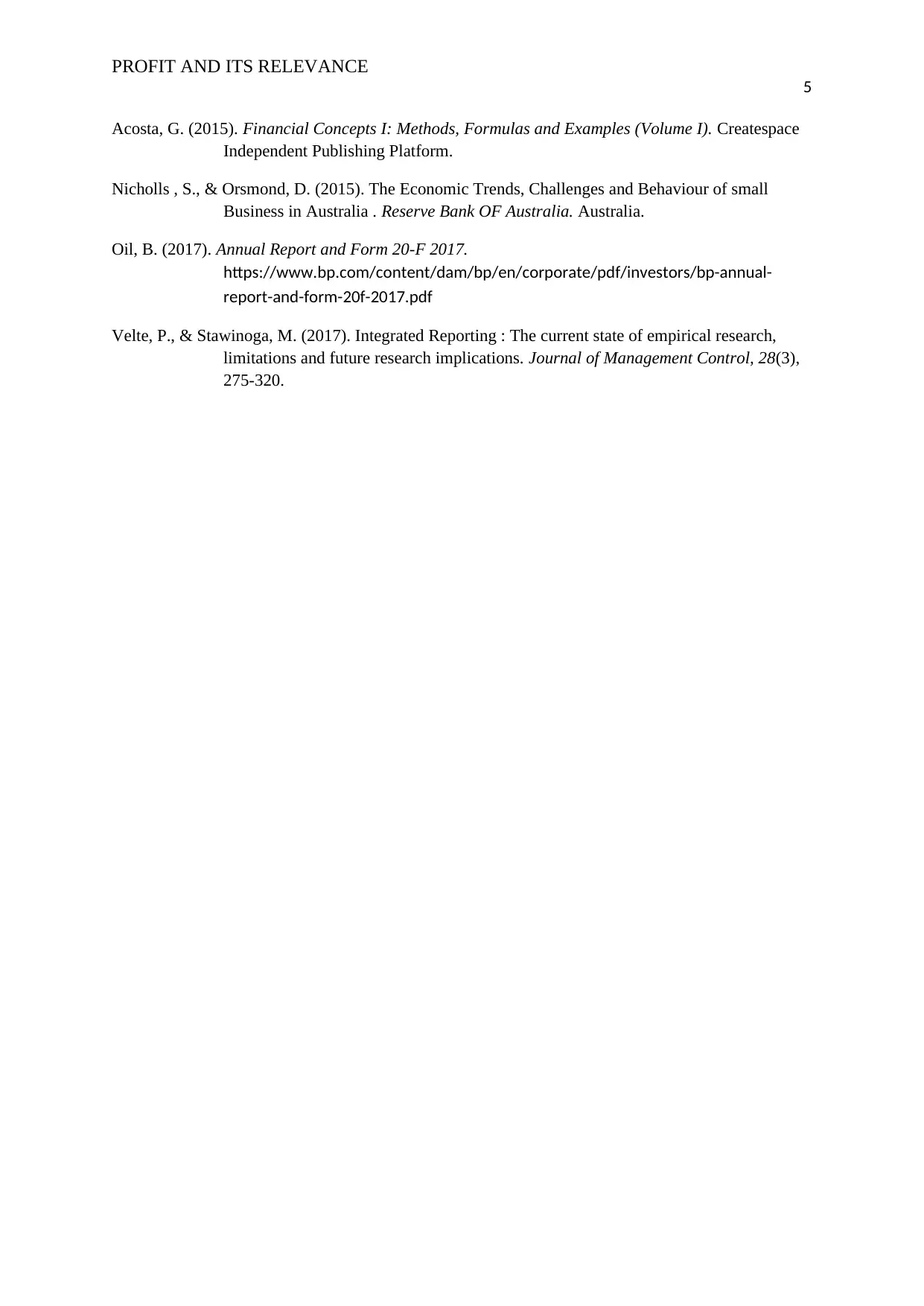BP Oil Profitability: Market Factors, Financial Statements Analysis
VerifiedAdded on 2023/06/14
|6
|752
|94
Report
AI Summary
This report critically analyzes the concept of profit for BP Oil Company from an investor's perspective, considering market factors and internal fund variability. It discusses why cash and profit differ, highlighting the impact of expansion costs and fluctuating revenues on BP Oil's financial performance between 2015 and 2016. The report also addresses limitations of financial statements, such as price-earning ratio discrepancies and varying accounting policies, which can mislead investors. Ultimately, the analysis concludes that profit alone is insufficient to determine a company's strength, referencing BP Oil's declining reserve replacement ratio despite reported profits. Desklib offers similar solved assignments and past papers for students.

Running Head: PROFIT AND ITS RELEVANCE
0
BP Oil Company
Profit and its Relevance
0
BP Oil Company
Profit and its Relevance
Paraphrase This Document
Need a fresh take? Get an instant paraphrase of this document with our AI Paraphraser

PROFIT AND ITS RELEVANCE
1
Contents
Introduction:...............................................................................................................................2
Factors affecting Profit:..........................................................................................................2
Why there is variance in cash and profit:...........................................................................2
Limitations of financial statements:.......................................................................................3
Price Earning Ratio:............................................................................................................3
Accounting Policies:...........................................................................................................3
Conclusion:................................................................................................................................4
Bibliography...............................................................................................................................5
1
Contents
Introduction:...............................................................................................................................2
Factors affecting Profit:..........................................................................................................2
Why there is variance in cash and profit:...........................................................................2
Limitations of financial statements:.......................................................................................3
Price Earning Ratio:............................................................................................................3
Accounting Policies:...........................................................................................................3
Conclusion:................................................................................................................................4
Bibliography...............................................................................................................................5

PROFIT AND ITS RELEVANCE
2
Introduction:
In this paper the concept of profit and its elusiveness with regard to the market factors
and the variability of its internal funds have been discussed. A company cannot be said
profitable on the basis of a single abstract rather it will depend upon a list of factors and
variables like market forces, supply and demand, business cycle, volume of sales and a lot
more (Acosta, 2015).
Factors affecting Profit:
Generally oil companies like BP oil, are influenced more by the exterior factors rather
than interior ones, like refining margins, demand for oil, oil price, geological prospects,
capital cost and environmental policy.
In alignment of these factors the two major concerns are being assessed below.
Why there is variance in cash and profit:
A lot of cash waves out of the company for buying equipment, machinery, leasing
premises and hiring employees to operate such technology and funds would have been ceased
by the time the revenue has been generated. This bridge of ‘expansion’ and ‘spending’ is the
crucial period in business (Nicholls & Orsmond, 2015).
After analysing the annual report of the BP Oil Company it states that the company’s
overall revenue is fluctuating. In the year 2015 it has been decreased from (7918) to (430) in
2016 yet the finance costs have increased gradually from 1,347 to 1,675 so even after setting
off the losses the cost to the company is robustly elevated (Oil, 2017).
As long as enough cash is available, company can expand comfortably to a more profitable
business rather than succumbing to panic.
2
Introduction:
In this paper the concept of profit and its elusiveness with regard to the market factors
and the variability of its internal funds have been discussed. A company cannot be said
profitable on the basis of a single abstract rather it will depend upon a list of factors and
variables like market forces, supply and demand, business cycle, volume of sales and a lot
more (Acosta, 2015).
Factors affecting Profit:
Generally oil companies like BP oil, are influenced more by the exterior factors rather
than interior ones, like refining margins, demand for oil, oil price, geological prospects,
capital cost and environmental policy.
In alignment of these factors the two major concerns are being assessed below.
Why there is variance in cash and profit:
A lot of cash waves out of the company for buying equipment, machinery, leasing
premises and hiring employees to operate such technology and funds would have been ceased
by the time the revenue has been generated. This bridge of ‘expansion’ and ‘spending’ is the
crucial period in business (Nicholls & Orsmond, 2015).
After analysing the annual report of the BP Oil Company it states that the company’s
overall revenue is fluctuating. In the year 2015 it has been decreased from (7918) to (430) in
2016 yet the finance costs have increased gradually from 1,347 to 1,675 so even after setting
off the losses the cost to the company is robustly elevated (Oil, 2017).
As long as enough cash is available, company can expand comfortably to a more profitable
business rather than succumbing to panic.
⊘ This is a preview!⊘
Do you want full access?
Subscribe today to unlock all pages.

Trusted by 1+ million students worldwide

PROFIT AND ITS RELEVANCE
3
Limitations of financial statements:
The potential investors scrutinize the financial statements of the company to weigh its
financial stability and strength of the business. Yet the financial statements are prone to
certain limitations (Velte & Stawinoga, 2017).
Price Earning Ratio:
The report of the BP Oil company in 2013 reflected highest profit attributable to
shareholders of $123.87 however it reduced to $17.20 in 2017. The investor might not invest
on account of poor price earning ratio as compared to previous years. On the contrary they
might miss the new projects and expansion or investments as they rely only on numbers and
ratios.
Accounting Policies:
The problem occurs when BP Oil Company is using different accounting policies in
calculation of inventory methods on FIFO basis while the other company might be using the
average cost method. This may lead to wrong assumptions to the investors in decision
making.
3
Limitations of financial statements:
The potential investors scrutinize the financial statements of the company to weigh its
financial stability and strength of the business. Yet the financial statements are prone to
certain limitations (Velte & Stawinoga, 2017).
Price Earning Ratio:
The report of the BP Oil company in 2013 reflected highest profit attributable to
shareholders of $123.87 however it reduced to $17.20 in 2017. The investor might not invest
on account of poor price earning ratio as compared to previous years. On the contrary they
might miss the new projects and expansion or investments as they rely only on numbers and
ratios.
Accounting Policies:
The problem occurs when BP Oil Company is using different accounting policies in
calculation of inventory methods on FIFO basis while the other company might be using the
average cost method. This may lead to wrong assumptions to the investors in decision
making.
Paraphrase This Document
Need a fresh take? Get an instant paraphrase of this document with our AI Paraphraser

PROFIT AND ITS RELEVANCE
4
Conclusion:
After the critical analysis of the financial statements of BP Oil Company in line with the
cash, profits and its overall stability it was observed the exploration activities increased and
the reserve replacement ratio in 14-15 could not cross 100% which is a standard benchmark.
Despite profits the company was running out of oil. Henceforth it can be concluded that the
profits are not a single source of determination of the strength and market share of the
company.
Bibliography
4
Conclusion:
After the critical analysis of the financial statements of BP Oil Company in line with the
cash, profits and its overall stability it was observed the exploration activities increased and
the reserve replacement ratio in 14-15 could not cross 100% which is a standard benchmark.
Despite profits the company was running out of oil. Henceforth it can be concluded that the
profits are not a single source of determination of the strength and market share of the
company.
Bibliography

PROFIT AND ITS RELEVANCE
5
Acosta, G. (2015). Financial Concepts I: Methods, Formulas and Examples (Volume I). Createspace
Independent Publishing Platform.
Nicholls , S., & Orsmond, D. (2015). The Economic Trends, Challenges and Behaviour of small
Business in Australia . Reserve Bank OF Australia. Australia.
Oil, B. (2017). Annual Report and Form 20-F 2017.
https://www.bp.com/content/dam/bp/en/corporate/pdf/investors/bp-annual-
report-and-form-20f-2017.pdf
Velte, P., & Stawinoga, M. (2017). Integrated Reporting : The current state of empirical research,
limitations and future research implications. Journal of Management Control, 28(3),
275-320.
5
Acosta, G. (2015). Financial Concepts I: Methods, Formulas and Examples (Volume I). Createspace
Independent Publishing Platform.
Nicholls , S., & Orsmond, D. (2015). The Economic Trends, Challenges and Behaviour of small
Business in Australia . Reserve Bank OF Australia. Australia.
Oil, B. (2017). Annual Report and Form 20-F 2017.
https://www.bp.com/content/dam/bp/en/corporate/pdf/investors/bp-annual-
report-and-form-20f-2017.pdf
Velte, P., & Stawinoga, M. (2017). Integrated Reporting : The current state of empirical research,
limitations and future research implications. Journal of Management Control, 28(3),
275-320.
⊘ This is a preview!⊘
Do you want full access?
Subscribe today to unlock all pages.

Trusted by 1+ million students worldwide
1 out of 6
Related Documents
Your All-in-One AI-Powered Toolkit for Academic Success.
+13062052269
info@desklib.com
Available 24*7 on WhatsApp / Email
![[object Object]](/_next/static/media/star-bottom.7253800d.svg)
Unlock your academic potential
Copyright © 2020–2025 A2Z Services. All Rights Reserved. Developed and managed by ZUCOL.





